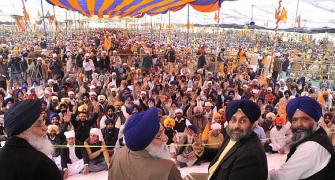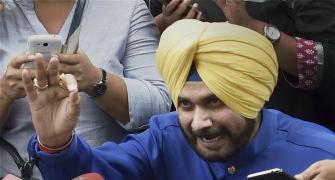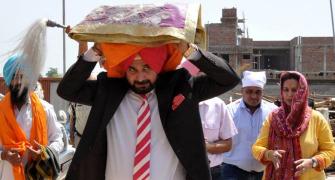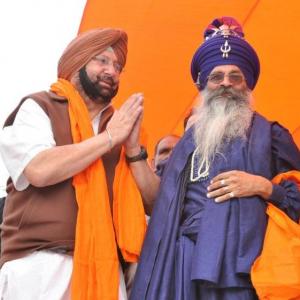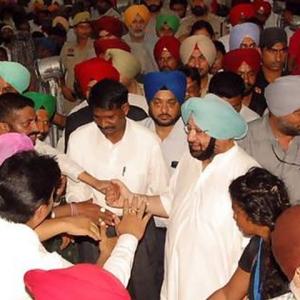Even as there is a strong anti-incumbency mood in Punjab, the multi-cornered contest has made the 2017 assembly polls prediction more difficult, report Sahil Makkar and Archis Mohan.

Punjab elections have largely been bipolar contests, mostly predictable. The voters invariably threw out the incumbent. That was until 2012, when neither pollsters nor politicians could read the mood.
The entry of a third contender, the Aam Aadmi Party, in the coming 2017 assembly polls in the border state has made predicting the outcome that much more difficult.
While the Shiromani Akali Dal-Bharatiya Janata Party coalition government faces a 10-year anti-incumbency mood, the Congress's Amarinder Singh has surprised people with his hard work. He has been known for leisurely poll campaigning but thanks to the goading from his party's election strategist, Prashant Kishor, this time's vigour is different.
In 2012, Amarinder was so confident of victory that he spent the gap between the last day of polling and the counting day in selecting his future council of ministers and key bureaucrats. The result, the first time an incumbent was returned since the 1960s, were a blow to Amarinder and a surprise to the SAD's Badals.
Detailed analysis of the 2012 results made the Akali victory surprising. The Congress had the highest vote share but won 10 seats less than the Akalis. Of these, the Congress lost eight by margins of less than 1,000 votes. There were four seats where the margin was less than 2,000 votes. As many as 22 of the 117 seats saw a close contest between the Congress and the Akali-BJP combine.
These 22 seats, observers predict, could again play a key role. Entry of new parties such as the AAP, the Awaaz-e-Punjab and the Apna Punjab Party, has made the contest multi-cornered.
"I believe the voters have still to make up their mind. You could even say they are confused. It is likely the anti-incumbency votes might get divided among the Congress, AAP and others, which could benefit the Akalis," says P P S Gill, former state information commissioner.
Observers say it would be a mistake to write off the Akalis. The party continues to be popular in the Malwa region, half of Punjab's 22 districts and electing 68 of the 117 seats. That the SAD could return to power in 2012 was primarily because of better performance in this region, increasing its tally from 19 seats in 2007 to 34.
The SAD government, led by Chief Minister Parkash Singh Badal and his son, also Deputy CM, Sukhbir, is promising to open the purse strings for the region. "The party is planning to spend around Rs 12,000 crore in the elections. This amount is enough to change the results, as voters in Punjab put their hearts before minds," says a veteran journalist, who has worked closely with the Akalis and the Congress.
Experts have been speaking of a post-Panthic, less ideology-driven and more transactional voter behaviour in recent elections. This March, the SAD-BJP government rolled out a populist budget, unveiling schemes such as free schoolbags to girls, cheap loans to women entrepreneurs, interest-free crop loans to small and marginal farmers, 4,000 modern gymnasiums for the youth and a Rs 100 crore scholarship fund for Dalits. The government also proposed to reduce stamp duty by 20 per cent. All this ignored the state's burgeoning debt and rising fiscal deficit.
This Budget was similar to its election-year Budget of 2011-12, when the SAD government announced free bicycles for girls, free health care facilities to backward classes and lowering of the qualifying age for pensions to women.
Even so, the Akalis' mismanagement of state finances, charges of corruption and failure to control the drug menace have created a groundswell of disaffection. The AAP, ever since the 2014 Lok Sabha polls, has tried to fill the space.
"Last time we voted for the Akalis but on this occasion the battle is to save Punjab. Another term to SAD will finish whatever prosperity the state is left with," says Lakhvinder Singh, who runs a retail shop in Ludhiana, the biggest town in the Malwa region. He says many small businesses and factories have shut down in the city in recent years, due to corruption and wrong policies of the government.
Asked about their first preference in the elections, most people we spoke to during a recent visit to the state were non-committal. Analysts say the AAP was going strong until two months earlier. AAP chief Arvind Kejriwal's public rallies were well attended and the party was being looked at as an alternative to the known political parties. While it would be early to write it off, the fact is in recent weeks its campaign has lost steam. The AAP burnt its fingers with its alliance with former BJP MP Navjot Singh Sidhu and its infighting.
Meanwhile, Amarinder has busied himself in trying to build the Congress position. Supported by Kishor and a team of workers, Amarinder has reached out to the public at large in a sustained campaign. His criticism of the AAP as a non-Punjabi force has found resonance. The former CM has also realised the need to prevent splitting of votes and reached out to Sidhu's Awaaz-e-Punjab to merge with the Congress.
To dispel the impression, which has strong basis, that Congress is a divided house, with tension between Amarinder, Partap Singh Bajwa and others, party leaders have taken out a 'Punjab Congress Express' since September 24. They have travelled together in a bus and held block-level meetings. The buses, according to the Congress, reached out to at least 1.1 million people and covered 4,420 km.
Amarinder has appealed to farmers to not commit suicide, saying he'd waive their loans within 100 days of coming to power. Next week, Amarinder is set to launch a 'kisan yatra', in which Congress Vice-President Rahul Gandhi is likely to join. Amarinder has knocked on the doors of farmers to hear their grievances and propose solutions. Until now, 112,000 'maang patras', lists of farmers' demands, have been collected.
The 'surgical strikes' on the Line of Control have also struck a sour note among people. The subsequent evacuation of villages, with farmers having to leave behind a standing crop, hasn't gone down well.
A source in Amarinder's war room said at present the Congress and the AAP were "neck to neck" but in the weeks to come, the Congress would pull ahead because of its campaign, while the AAP would lose steam. However, as 2012 showed, the Akalis are known to fight back and the AAP, as it showed in the 2014 Lok Sabha poll by winning four of Punjab's 13 seats, can spring a surprise. Dera Sacha Sauda, which wields enormous influence on the 34 per cent Dalits of the state, is also yet to indicate its preference.
In sum, Punjab is set for an interesting next three months.
IMAGE: A file photo of voters lining up to cast their votes at a polling station at Banur in Punjab. Photograph: Ajay Verma/Reuters.


